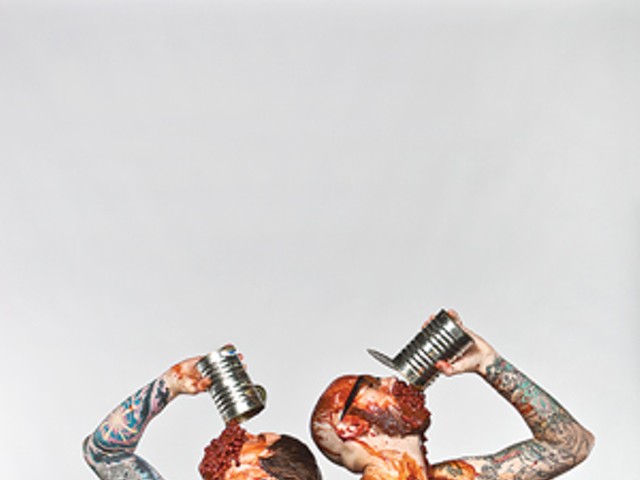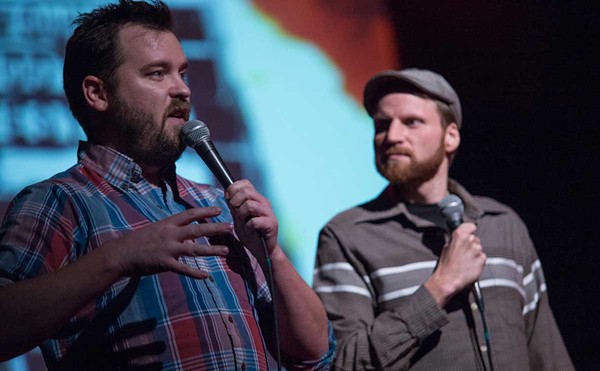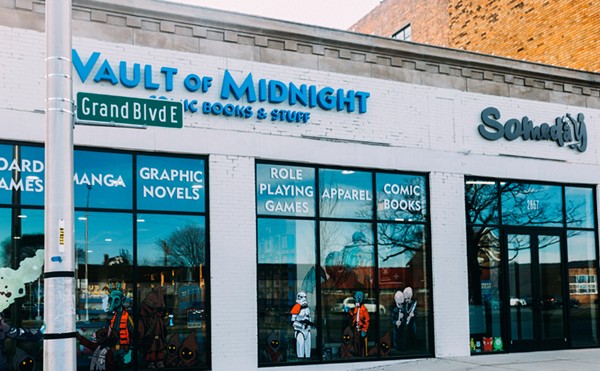Before getting into the charred thickets of east Detroit, you'll pass the old train yard. In certain areas you'll see stray dogs, vagabonds, curious shutterbugs, countless pounds of broken glass and gnarly graffiti art. It's been that way for decades. For taggers, burners and bombers with a blunt and a backpack full of Krylon, it's a free studio and vast gallery that operates, sans curator, in constant flux. Today, a decent stretch of the train yard, from the Detroit River north to Eastern Market, has been re-purposed as a well-lit greenway and bike path, with emergency phones and park benches. It's everything the city needs more of. And it's along this sliver of transit space that you can find some of the yard's best graffiti.
If Kobie "Rift" Solomon had his way, the most talented graffiti artists in the world would meet in Detroit and paint mega-murals down the whole yard. That's where they'd get started, anyway. Back in the day, you could catch Solomon down in the yard. Well, you probably couldn't catch him — but that's where you could see some of his work. Chances are, you have seen his paintings, whether on a rooftop or highway underpasses, at some point during his 15-year career.
Having found a balance between nocturnal rebel works and those commissioned (for the city, and business and gallery shows), this 32-year-old's latest attempt to bring graffiti to living rooms comes through the release of My First Graffiti Coloring Book, a work that offers a hip-hop education by way of 26 different graffiti styles. Solomon, who was born and raised in the Detroit area, has much to say.
Metro Times: Graffiti has, of course infected pop culture pretty well — is it still disrespected?
Kobie Solomon: There's a lot of people who don't appreciate it. Aside from some of the cultural biases those people have, if it was presented to them the right way, they could learn to love it for what it is. As early as the Middle Ages there were lettering masters found around the world; in China and Japan, masters of character work were revered in their society for keeping the written word alive. As an art form, it somewhat died out with the advent of technology, with computers and fonts and whatnot. But that's who I think graffiti artists really are — we're like the keepers of the script, the masters of the letter.
MT: How did you discover it?
Solomon: I went to a suburban high school and a lot of kids were just puttin' up little scribble tags, so I kind of got into it from there. I got ahold of the first issue of 12 oz. Profit — it smacked me in the face. After that, I got ahold of Subway Art by Martha Cooper and Henry Chelfont. I found that in my high school library and when I flipped through the pages I was instantly blown away. Then I started dicking around with it because it was fun to get into trouble too. There's the whole adrenaline aspect of it. We were lighting up high schools, we lit up a entire newly built wall along a stretch of I-75 too. Man, we were killing it. The liaison officer at my high school was pretty much onto us. He had pictures of the stuff, but he didn't have pictures of anyone putting it up, he didn't have incriminating pictures, but he was getting serous about it. I've still never publicly said which name I was using because those cops probably still hate my guts. I cost that city too much money — even just my senior prank probably cost $3,000 to fix. By the time I moved down into the city in 1995, to go to CCS, I was pretty much addicted.
MT: Does that weigh on you now that you're older?
Solomon: No — not at all. I was younger and I was crazier. I was bonkers. It's called payin' your dues. I didn't go all-city with it and I didn't get up a lot in the hood, so a lot of people doubt my legitimacy because of the commercially commissioned stuff, like the piece I had at the Town Pump and the Corktown Mural I did for the city, but I paid my dues like everybody else, man: I've run from the cops, climbed on buildings and jumped off of them, hopped on moving trains, frozen my fingers painting in the winter. I don't regret any of it.
MT: When the sun sets, does a part of you itch to go into the night with your paints?
Solomon: Oh, yeah — and there's the whole ritual to it. If you have a sketch, you grab it, but you might just be winging it, and that's cool too. Then you go out like a ninja. If you're a drinker, you get a little buzz on and bring a few with you; if you're a smoker, twist up a blunt, get baked, and bring some for the trip. Go through your paints and anticipate how many cans you're going to use. When you've been into it for a long time, you know exactly how many cans of paint you're going to need — that's your ammunition. ... If you don't want to get questioned with evidence all over your fingers, you get your gloves; if you don't like breathing the fumes, you get a mask. Throw it all in the backpack.
MT: Being a graffiti artist has to be one of the most physically demanding forms of visual art.
Solomon: I know two graffiti artists in the city who are up everywhere — they're all-city. One of them I went to CCS with, the other one, I believe, was a student there too. Both of these individuals amaze me with the pieces that they get and where they get them. There've been times when I've seen something they've done that left me dumbstruck, like, "How the fuck did they get up there? How did they do that?" It's less about a person's size and strength and more about their desire to get their work out there. It just twists my head back, and I'm a break-dancer and a skateboarder.
MT: Are you trying to finish a piece in one setting or do you have to come back to it for a few nights?
Solomon: It depends. If you're puttin' up full-blown burner — like a big, badass, multi-color piece — those usually require more than one session.
MT: What's the difference between a burner and a bomber?
Solomon: Bombs are usually the illegal pieces, the big, multi-color blasts that make you wonder how the artist didn't get caught doing it. They're the bombs — it's like an explosion in your face.
MT: So the bomb trumps the burner?
Solomon: It depends on the bomb and its placement and how dope the letters are, how dope the fill is. You can have a sick, sick, sick burner that took you forever and has three dimensions and wild-style letters, but if someone comes up behind you and does something that is technically close to yours but they put it on top of a building in the middle of a flat-faced wall 100 feet from the ground and 50 feet from the roof and there are no footholes — you got trumped!
MT: Do graffiti battles still exist?
Solomon: Yeah, they still go on. Kids are getting their asses kicked, some have been stabbed. You know, there's a couple dumb-asses out there. ... I think it's just ridiculous. What's the point? There's a lot of talent here, some of these kids do incredible things with cans of spray paint, but there's isolation. It's how we operate. Even in our own city, the crews are isolated from each other — voluntarily or otherwise.
MT: What's the answer?
Solomon: Primary Flight is the largest street-level art installation in the world. It's a unifier. The vast majority of the best graffiti artists on earth come together to do a whole neighborhood in Miami during Art Basel. It's the best of the best of the best and it's completely legal, sanctioned by the city with a corporate sponsor. We were given an area about the size of Hamtramck to work with and I only saw about 20 percent, if that, of the art completed the week we were there. CPOP is actually trying to get something like a Primary Detroit together. That would be huge for the city and for local artists. What the municipality has to understand is that if we brought in the world's best graffiti artists to put up bombs in designated areas, the art would stay up for a long, long time. They think it'll breed scribble tags and shit, but kids won't touch that art out of respect. Like anything, there's a code.
Sketches in Grit is a recurring column that looks at Detroit's fringe artists. Send letters to [email protected]




